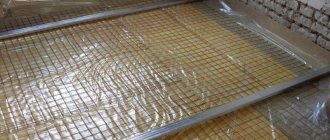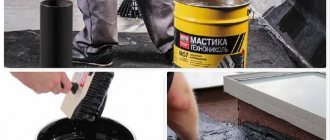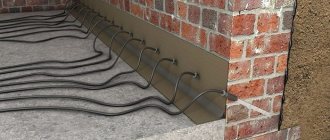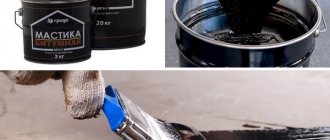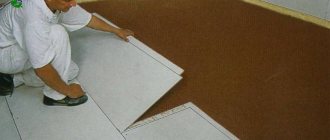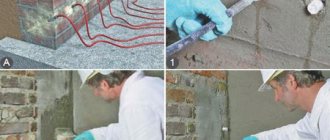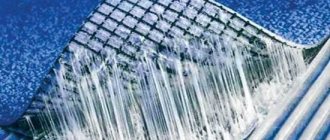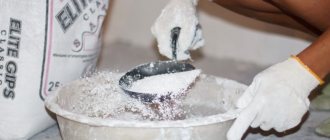Even taking into account the fact that manufacturers are trying to create more and more new materials, bitumen mastic still retains the title of the most popular waterproofing material. It is actively used not only in private, but also in capital construction for waterproofing concrete structures, as well as for laying certain roofing materials. It is often used for repairing various surfaces. For a long time now, no one has doubted the usefulness of this material. But even he must be treated correctly so that he fully demonstrates all his best qualities.
Main classification of bitumen waterproofing:
Bitumen products are divided into several main types, the difference of which is mainly due to the method of their construction and application.
- hot
- Cold
Hot bitumen waterproofing
When working with hot bitumen, it must be heated in a bitumen cooker so that the mixture can be evenly spread or applied to the surface. The substance is applied to a clean surface without dust and dirt using brushes and rollers. A layer consisting of hot bitumen dries quickly and does not shrink when set. Despite the low cost of the material, the surface is seamless. When preparing the material, you should be careful; burns are a common occurrence in this matter. It is also possible that smoke may be released and soot may settle during preparatory measures. Quick drying can be a disadvantage of this type of composition, since you have to work quickly, otherwise the mass will become too viscous. In order to maintain hot bitumen in a liquid state, a special platform or special equipment is required. This type of coating quickly becomes viscous, and the transition to a solid and more durable state takes relatively longer. The use of this material is not economical; working with one cubic meter of surface requires a larger amount of mastic, about 2 kg.
Important: When preparing for work with hot bitumen, as well as when performing the work itself, it is necessary to follow safety and labor protection requirements, otherwise such work may result in burns, severe injuries and death both for the work operator himself and for those around him of people.
Cold bitumen waterproofing
Cold bitumen waterproofing is called mastic, which does not need to be heated before use.
Cold formulations are divided into 2 types:
- Solvent-based - Before use, just add a little solvent and the composition is ready for use.
- Water-based (so-called emulsions) – These coatings are more environmentally friendly and less flammable, which is why they are more often used for work in residential areas, such as basements, basement walls and floors.
In general, the advantages of cold bitumen over hot bitumen are:
- Cold bitumen does not require much time to prepare;
- Materials of this kind are characterized by adhesion to all types of surfaces, in addition, they are very plastic and elastic, which makes the process of working with them much easier and more enjoyable;
- The compositions harden quickly, but do not quickly become so thick that they are difficult to work with;
- Such materials are more mechanically strong and also better withstand temperature changes, that is, generally more reliable and durable.
One of the main disadvantages of this kind of mastics compared to hot ones is their higher cost.
Comparison table between cold and hot mastics
| Characteristics | Cold with solvents | Cold water based | hot |
| Layer thickness in mm | 0,5-1 | 0,5-1 | 1,5-2 |
| Consumption kg\m2 for 1 layer device | 1-2 | 1-1,5 | 2-3 |
| Drying time at a temperature of +15C and above in hours | 12-24 | 3-6 | 2-4 |
| Withstands external temperatures | -15 to +45 | +0 to +45 | -5 to +45 |
| Sputtering device | No | Yes | Yes |
| Device without live fire | Yes | Yes | No |
Outside or inside?
It is better to protect your home from water in a comprehensive manner: waterproofing walls should be carried out on the external areas of the building and its internal surfaces. In the absence of external waterproofing, mold and dampness are guaranteed to appear in the home. For complete protection, the foundation must be treated with compounds both outside and inside: the ground floor is in contact with the ground on both sides.
The difficulty in implementing external waterproofing lies in the fact that this type of work must be carried out during the construction of the building. If it has already been built, then waterproofing the walls requires excavating the foundation.
It is good if the building is surrounded by land. But most often asphalt paths are laid around it. They will need to be dismantled, a trench excavated in the ground along the foundation, waterproofing done, then the trench buried and the area around the house paved again.
Therefore, waterproofing the external walls of an already constructed building will be expensive. In this case, it is better to carry out such work from the inside.
Types of bitumen-based waterproofing mastics
Mastics can be divided among themselves according to the main added component:
- Bitumen;
- Bitumen-polymer – With the addition of various polymers;
- Bitumen-rubber - With the addition of polymers and latex, resulting in the so-called elastic and seamless “Liquid rubber”;
- Bitumen-rubber – With the addition of rubber;
- Bitumen-emulsion;
- Polymer.
The properties of a particular material depend on its composition and what substances were added to it at the production stage. The constituent elements most often are mineral salts, resins, carboids and paraffin. There are one-component and two-component formulations.
Coating bitumen products can also be divided according to the number of components:
- One-component;
- Two-component;
- Multicomponent.
Bitumen-polymer
They have thixotropic properties, that is, the ability to increase viscosity at rest and decrease viscosity when exposed to external factors. This property allows the coating not to drain from vertical surfaces. Materials of this composition are very durable and do not corrode, which allows them to be used on surfaces such as metal. This is the most stable and reliable type of bitumen mastic, which does not crack in the cold or at high temperatures. Mastic with the addition of polymers is capable of healing its own cracks, provided that they are no more than 5 mm.
Characteristics:
| Device method | Coating |
| Consumption kg/m2 | 0,5-0,8 |
| Drying time in hours | 3-12 |
| Main component | Bitumen |
| Material suitable for | Concrete, brick, Metal, Plaster, Wood, Cement |
| Adhesion strength to concrete (MPa) | 0.1 |
| Adhesion strength to metal (MPa) | 0.1 |
| Application temperature (°C) | -20 to +45 |
| Mass fraction of non-volatile substances (%) | 40-80 |
| Heat resistance | 40-80 |
| Tara | Bucket |
Bitumen-rubber
Contains no solvents. Due to its density, it can be used for waterproofing various surfaces. Elasticity allows the composition to compensate for surface movements. In appearance, this type of waterproofing material is similar to a thick coating mass.
Characteristics:
| Device method | Coating |
| Consumption kg/m2 | 0,8-1,5 |
| Drying time in hours | 2-24 |
| Main component | Bitumen |
| Material suitable for | Concrete, brick, Metal, Plaster, Wood, Cement |
| Adhesion strength to concrete (MPa) | 0.1 |
| Adhesion strength to metal (MPa) | 0.1 |
| Application temperature (°C) | +0 to +45 |
| Mass fraction of non-volatile substances (%) | 70-80 |
| Heat resistance | 50-90 |
| Tara | Bucket |
Bitumen-rubber
After application, the resulting coating looks like rubber, which is why people call it “liquid rubber.” Liquid rubber consists of modified bitumen with the addition of latex, which increases the elasticity of the material. Liquid rubber waterproofing is ideal for providing a protective coating for various parts of buildings and structures located underground, as it has the following properties:
- Seamless;
- Elasticity;
- Environmental friendliness;
- 100% adhesion to the base;
- Resistant to minerals and salts.
More information about the design of this coating and spraying insulation can be found in the article – “Waterproofing with liquid rubber.”
Criteria for selecting options
When deciding which material will create good waterproofing in a particular case, experts make the following requirements:
- tensile strength;
- flexibility;
- resistance to chemical reagents;
- elongation at break;
- durability;
- elasticity;
- minimal water absorption;
- resistance to punching.
When choosing a material for roll waterproofing, pay attention to durability and tensile strength
Roll variations are most suitable for DIY installation; they do not require additional labor. The most popular materials are made of fiberglass impregnated with polymer-bitumen mastic.
Installation of bitumen waterproofing - step-by-step instructions
The installation of coating or sprayed bitumen-based waterproofing must be carried out in a certain order and strictly following the instructions:
- Surface preparation. Cracks and bulges should be leveled with the main sheet; if there are concrete joints, they must be compacted in advance. Before installing the insulation, it is necessary to thoroughly clean the base on which the coating insulation will be applied. The base must be cleaned of sharp stones, deposits, dirt and dust. High-quality preparation will allow the material to cover the base well and subsequently adhere well to it. These operations should be given due attention, since if they are performed correctly, a high-quality result is guaranteed.
- Arrangement of fillets or transition fillets. To prevent fracture or static punching of the future waterproofing coating, it is necessary to install a so-called fillet at all transitions between the horizon and the vertical. The fillet can be made from cement-sand mortar of a grade not lower than m-150.
- Primer of the base (application of primer). Before installing bitumen spraying or coating mastic, it is imperative to use a primer. A primer or primer increases the adhesion of the waterproofing layer; before applying the primer, the surface on which it will be applied should be dried. If the primer will be used in a residential area, you can use an infrared heater.
- Waterproofing device from various bitumen compositions. First you need to select the right tool. The choice of working tool depends on the consistency of the applied composition. If bitumen mastic is liquid, then it should be applied using a brush or roller. The material is applied in several layers, and the thickness of the waterproofing should not exceed 1.5 mm, and each new layer is applied in a perpendicular direction to the old one. Before applying each new layer, you should make sure that the old one is completely dry, so it is important to choose the composition that will help you spend less time on it. Thicker mixtures, more like a paste, are applied by coating using a spatula, regular or notched. Thick mixtures can be applied in several layers, although sometimes you can get by with just one. Each layer should be more than 3 cm thick. The second layer of mastic is applied to the dried first one.
- After installing coating insulation, the surface must dry. During the setting of the composition, the settling of dust or any other small particles is unacceptable. After the building material has completely dried, repairs can continue.
Important: Each manufacturer has its own detailed instructions for the correct design of its materials. When carrying out work, you must carefully study the manufacturers' instructions and follow them throughout the entire process.
Pasting principle
This is a roll waterproofing material that is highly resistant to rotting processes. Only a combination of pasting and coating materials will reliably protect external and internal surfaces from moisture.
Insulating external walls using rolled material also begins with cleaning them from dust, debris, and soil residues. After this, a primer and 2-3 layers of bitumen-polymer mastic are applied to the surface.
To fix the pasting materials, use a torch or a hair dryer. The first layer is glued horizontally, starting from the foot of the foundation. The waterproofing strips are treated with a torch, pressed tightly to the surface, and smoothed to remove air.
The overlap of the strips should be 15-20 cm. The second layer is fixed vertically, perpendicular to the first. Carefully handle the joints.
Internal protection
You can prevent the penetration of moisture from inside the structure using penetrating mixtures. With their help, hydro- and vapor barrier of walls in the apartment is carried out, the foundation and internal walls of basements are processed.
After cleaning the surface of the walls from dust and debris, they are moistened.
The waterproofing agent is diluted with water according to the instructions on the package. Wet surfaces are first treated horizontally. Allow the first layer to dry (3-4 hours). After this, the material is reapplied, but vertically.
After polymerization, the protective layer of the walls must be at least 2 mm. Check the thickness as follows: cut out a square measuring 2x2 cm with a knife and take a measurement using a caliper.
Waterproofing walls is an important stage in the construction of any building. It’s not difficult to do it yourself, the main thing is to choose high-quality materials and apply them correctly.
Safety precautions when preparing and using hot and cold bitumen mastics
When working with coating materials that require fire or high temperature for preparation, you must follow all safety rules when working with fire and all labor protection requirements during such work.
Basic Rules:
- To ensure fire safety, it is necessary to have a box of dry sand with a capacity of 0.5 cubic meters near the place where flammable emulsions are heated and prepared. shovels, fire extinguishers;
- The place where bitumen is cooked and heated must be located on the surface of the earth, no closer than 2 m from the edge of the pit and be fenced with special sides made of non-combustible products with a height of at least 0.3 m;
- The heating container must have a tight-fitting lid;
- Containers for cooking and heating bitumen must be equipped with a device for measuring temperature;
- Filling the boiler is allowed no more than ¾;
- Pieces of bitumen must be lowered along the walls with care, avoiding splashing;
- Compositions can be heated indoors only in special electrically heated containers without open flame;
- During the cooking or heating process, it is not allowed to leave the equipment unattended;
- It is unacceptable to use open fire within a radius of 50 m from the place where bitumen is mixed with solvents;
- Do not heat the solvent while preparing the mastic;
- Combustible elements must be delivered to the construction site in closed metal barrels with tight lids that cannot be opened if the barrel falls;
- The supply of hot barrels into the pit is permitted exclusively through platforms at least 1 m wide with protective fences without the use of ladders for transfer;
- It is prohibited to transfer barrels from hand to hand.
safety of waterproofing works
Which one is better to choose?
Preference is given to ready-to-apply waterproofing mastics for foundations and floors that can withstand short-term exposure to water under pressure in excess of 0.003 MPa and have minimal (ideally no more than 1-2%) water absorption rates after drying.
When choosing a specific brand, the following are taken into account:
- adhesion indicators with concrete and rolled materials (the higher they are, the better);
- declared consumption and proportion of dry non-volatile substances in the mastic residue;
- heat resistance of the mastic (ideally above 100 °C, but not less than 70);
- appearance and weight of the composition - high-quality mastic has a uniform plastic structure and weighs less than water, in practice this means that its weight should not exceed the volume of the container; heavier, cheaper brands crack faster and collapse after 1-2 years.
Specialized brands TechnoNIKOL and Grida MGH-G meet these requirements. The use of universal mastics (essentially roofing mastics) is permissible only on dry, non-aggressive and permeable soils, shallow foundation depth and low groundwater level.
Bituminous waterproofing GOST
Various waterproofing and roofing bitumen products have uniform standards and technical conditions that determine the following points:
- Requirements for raw materials and materials;
- Marking;
- Package;
- Safety requirements;
- Acceptance rules.
On our website you can download the current edition of the relevant GOST standards by clicking on the following link - Waterproofing mastics GOST 30693-2000.
Brief overview of the work process
In order to be able to control the quality of the house construction work, as well as its component parts, it is necessary to have at least a general understanding of the nuances. For example, if you plan to use rubber-bitumen mastic, you should know that it is suitable for a temperature range of -50°...+110° degrees Celsius. But before that, you should definitely warm it up at least at +5°. There are also relevant questions regarding the tools used. There are two options here:
- Hand tool. It is better suited in cases where it is necessary to treat small areas of coverage, apply bitumen mastic in limited space and cramped conditions.
- Mechanical tool. Used when working with large areas. Using a compressor with installed sprayers allows you to quickly treat the surface of the foundation with a composition from cylinders.
Mechanical tools are synonymous with fast work. Source nashaotdelka.ru
Knowing small nuances, you can assess the qualification level of those who will perform the work. By the way, bitumen-rubber mastic is suitable not only for working on the house, but is also loved by motorists. This material has good adhesion and is used with equal success on both horizontal and vertical planes. It provides protection not only for concrete and wood, but also for metals. The matter is not limited to the material.
At the same time, the challenge associated with finding reliable and efficient builders is relevant. Everyone chooses for themselves who will be involved in making the dream of their own home come true. But before doing so, it is advisable to compare at least several different companies to get the best idea of how things stand.
Video description
And finally, a short video for everyone who is just thinking about building their own home and studying material on this topic:
Bituminous mastic has all the necessary properties that allow it to be effectively used for waterproofing and protecting a home from moisture. And knowing the information provided, you can exercise effective control over the execution of work. After all, no one knows better than the customer what he needs. And in order to get the desired result, you should maintain feedback and, if necessary, make adjustments.
